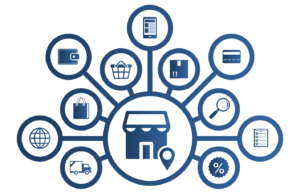Omnichannel Retail Best Practices & Implementation
Omnichannel Retail Best Practice “Omnichannel” goes beyond e-commerce and digital marketing. It is not another channel but an approach in which retailers create a seamless shopping experience that integrates online, offline, and mobile. Partners include Adobe, Accurate, Auto Trader, eBay. Customers are becoming used to purchasing in various ways because omnichannel retailing is becoming the norm. When customers used to walk into a physical business to look around and make purchases, the tale ended there.
Consumers may now compare products or services using their smartphones, iPads, and computers. They may go to an actual store to look at a product but wind up purchasing it online.
What is precisely Omnichannel retail?
The concept of Omnichannel retailing refers to businesses that sell to a particular client across various channels. Omnichannel retailing solutions must allow customers to easily transition across their shopping touchpoints as they buy a product. Why?
- It’s simple for your clients to interact with and purchase from you when they shop with you.
- Across many sales channels, your business can provide flexible, individualized service and establish consumer loyalty.
These eight practices will help you avoid avoidable complexities. Now your plans on the course, regardless of whether you have yet to design an Omnichannel approach or are in the middle of implementing one and seeking improvements.

Benefits of Omnichannel retail
The advantages of an integrated retail strategy throughout online and physical channels are apparent. However, you cannot go ahead with a partially Omnichannel Retail Best Practice approach. To overcome the competition and cater to modern-day customers that display complicated buying patterns, you must enhance your processes.
Retail Omnichannel best practices

1-Focus on Adaptability and Stability
73% of individuals who participated in Harvard Business Review’s poll switched between numerous channels throughout their customer journey, according to their findings. You will prevent stumbling blocks in the consumer journey by making it easy for customers to switch between platforms without losing crucial data.
To achieve these seamless transitions, we will maintain data continuity on the back end. Changing gadgets or being unable to locate what you’re looking for owing to significantly changing layouts causes no one to want to start their buying process all over again. Being consistent lessens the chance that you will get frustrated.
It’s common for older organizations to rely on software that restricts access to client information to only a few people in the company. If other departments are unable to use the data in this way, it won’t be easy to build a comprehensive profile. However, all relevant areas of a corporation may make the most of this data by breaking down silos.

2-Provide access to the Internet of Things
The Internet of Things (IoT) and its importance in daily life and business grow every year. With Gartner estimating that 20.4 billion IoT-connected devices would be in use globally by 2020. Studies suggest that this kind of connection will continue to rise in use in the future. As a result, enabling your software, devices, and applications to interact and connect with those to provide the Internet of Things will also allow today’s consumers. It has distinct Omnichannel Retail Best Practice expertise. It enables future IoT incorporation to be following measures as its role in everyday life grows.
3-Updating Information in Real-Time
When it comes to having an Omnichannel Retail Best Practice experience, in real-time, anything from an item’s order status to a customer’s search history must be kept up to date.
In a recent survey, 71 percent of consumers said they expect to be allowed to browse the business’s inventory online, and 50 percent expect to be allowed to purchase the shop and order up in the store. By integrating online information with store inventories, businesses may prevent consumers from going through a long process to discover that the services they need are unavailable.
4-Manage the intellectual resources
To effect real change in your business, you’ll need the proper individuals at the top of the corporate ladder. In addition, all workers must support and behave in line with the company’s plan. From the CEO to the shop workers, all employees must be on board with the new approach. Organize teams in a way that facilitates cross-channel communication.
5-Recalculate the metric
A shift to Omnichannel marketing eliminates the need for outmoded multi-channel KPIs. A single cause inside the business cannot be traced back to increased sales in shops. The addition of a new feature in your app or modifications to your online marketing strategy might lead to an increase in revenue. Tracking performance across all channels is essential for an integrated Omnichannel strategy to assess success.
6-Consider the Usage of Your Channels
You can put your channels to good use in many ways, and you should give each of them attention. To better understand how your customers interact with your products and services, it is vital to study their habits. In-depth metrics that track time spent, frequency of usage, user routes, bounce rates, referrals, profiles, and other factors provide you a clear picture of how various customers interact with your company’s website and, ultimately, whether or not they make a purchase. Also, consider how your firm communicates inside and whether procedures could be improved to avoid duplication and issues.
7-Enhance Your In-Person Experiences with Digital Media
The two should work together to create fresh and exciting experiences for both online and in-person encounters. Augmented reality, for example, may enable consumers to experience virtual components of a business while they are in the store, allowing for exceptional and original interaction.

Instead of relying just on an online presence and abandoning in-person encounters, a company can embrace the whole Omnichannel experience this way. A Pottery Barn augmented reality app has just released. In fact, it allows users to view how the brand’s furniture would look in their actual living environment. We may expect a more coherent experience when these sorts of experiences are blended.
8-Utilize Messaging to Address Audience Needs
People utilize messaging apps like Facebook Messenger to interact with companies more than ever before. Rather than phoning a customer care representative or asking their queries in person, audiences adopt messaging applications to engage directly with staff and even buy items or services. Various ways are used to address these message requirements, including the expanding usage of chatbots, including messaging into a more comprehensive Omnichannel strategy adds another channel of contact and prevents audiences from feeling as if their whole experience with a brand is lacking.
Please visit more informative blog..









